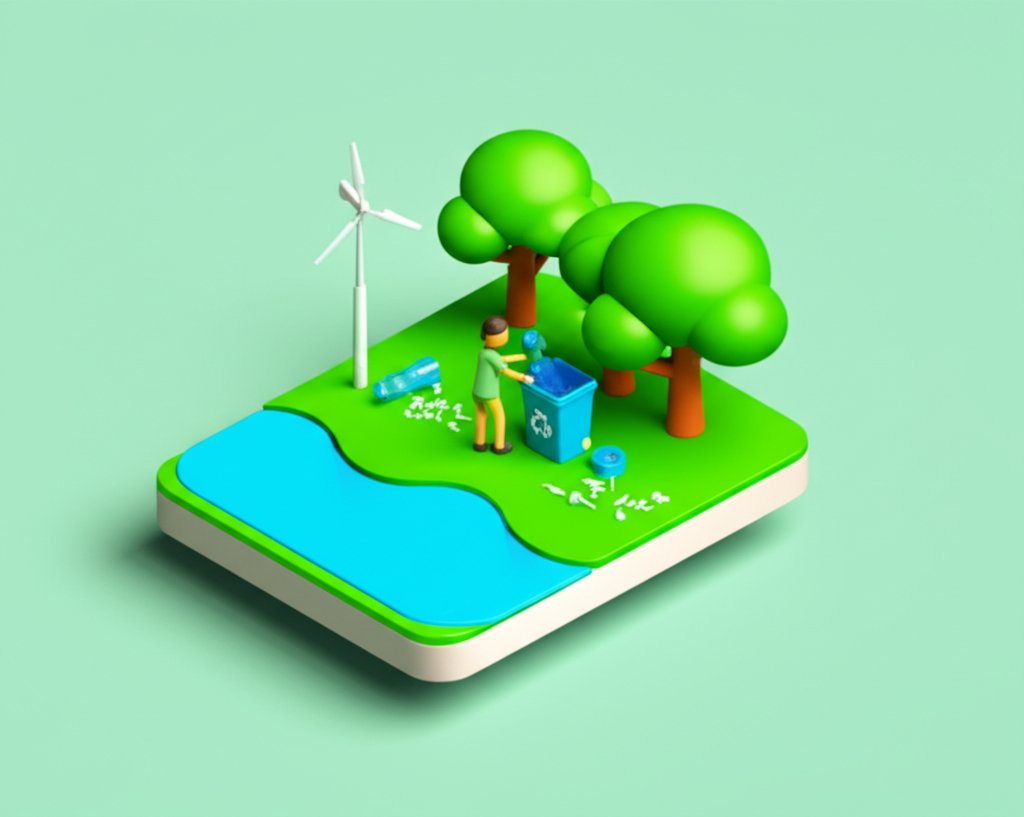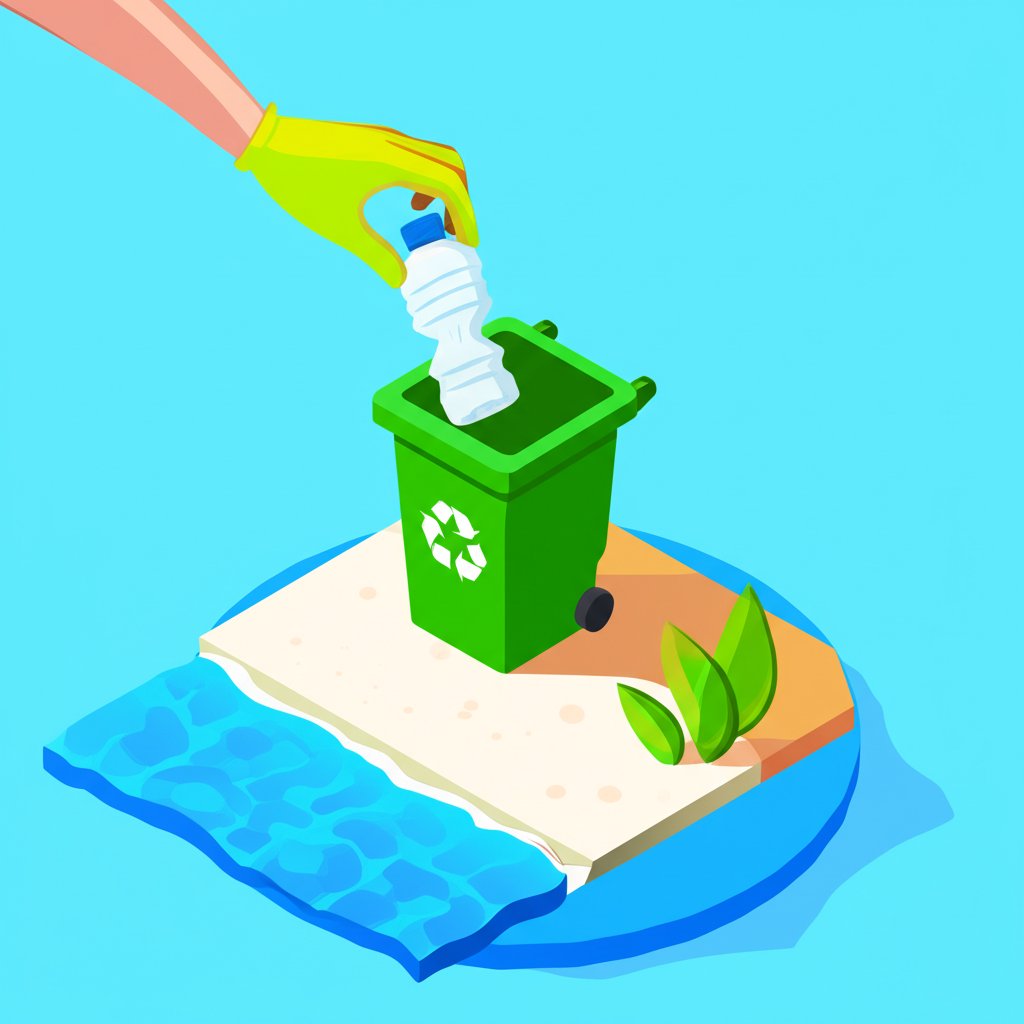The sheer volume of plastic pollution saturating our planet presents one of the most pressing environmental crises of our time. From towering landfills to swirling ocean gyres, discarded plastics damage ecosystems, endanger wildlife, and infiltrate our food chains. It’s a problem that can feel overwhelming, but the good news is that every individual action, combined with systemic change, has the power to reduce plastic pollution significantly. This article will delve into five impactful strategies you can adopt today to combat plastic waste and foster a cleaner, healthier future.
1. Embrace Reusable Alternatives & Mindful Consumption Habits
The first and most direct way to reduce plastic pollution is to minimize the demand for new plastic products. This means consciously choosing reusable alternatives over single-use disposables in every aspect of your life.
The Power of Reusable Alternatives in Daily Life
Think about the plastics you encounter daily: water bottles, coffee cups, shopping bags, food packaging. Each of these represents an opportunity for a sustainable swap. Investing in high-quality reusable alternatives isn’t just an eco-friendly choice; it often saves money in the long run and enhances convenience.
- Hydration: Ditch bottled water. A durable stainless steel or glass water bottle is a must-have. Many cafes now offer filtered water refills, and some even provide discounts for bringing your own.
- Beverages on the Go: For your coffee or tea fix, a travel mug eliminates countless plastic-lined paper cups and plastic lids. Pair it with a reusable alternative like a stainless steel or bamboo straw if needed.
- Grocery Shopping: Always carry reusable alternatives for shopping bags (canvas or jute are excellent). Go a step further with mesh produce bags for fruits and vegetables, avoiding the thin plastic bags provided in stores.
- Meal Prep & Takeout: Pack your lunch in reusable alternatives like glass containers or bento boxes. When ordering takeout, inquire if you can bring your own containers or if the restaurant uses compostable packaging. Keep a set of reusable alternatives for cutlery (bamboo or stainless steel) in your bag for unexpected meals out.
- Home & Kitchen: Replace plastic cling film with beeswax wraps or silicone lids. Opt for reusable alternatives like cloth napkins instead of paper tissues. Even small items like dish sponges can be replaced with more durable, natural options.
Smart Shopping to Avoid Unnecessary Plastic Waste
Beyond direct reusables, consider your purchasing power. Brands respond to consumer demand, so choosing products with less plastic waste sends a powerful message.
- Buying in Bulk: Many stores offer bulk bins for grains, nuts, spices, and even cleaning supplies. Bring your own reusable alternatives (jars, cloth bags) to fill, dramatically cutting down on packaging plastic waste.
- Prioritizing Minimal Packaging: Look for products packaged in glass, metal, cardboard, or with minimal plastic wrapping. For example, choose bar soap over liquid soap in plastic bottles, or shampoo bars instead of bottled shampoo.
- Supporting Sustainable Brands: Research companies committed to reduce plastic pollution through innovative, eco-friendly packaging or closed-loop systems. Your purchasing decisions can drive industry change.
- Avoiding “Greenwashed” Products: Be wary of terms like “biodegradable” or “compostable” on plastic products without clear certification. Many require specific industrial conditions to break down and simply become another form of plastic pollution in landfills or the environment, as highlighted by expert insights on “honesty about what is sustainable.”
2. Master Proper Recycling & Waste Management Practices
While reducing consumption through reusable alternatives is paramount, some plastic waste is inevitable. Mastering proper recycling is crucial to diverting these materials from landfills and oceans and transforming them into new products, thereby closing the loop in the circular economy and further helping to reduce plastic pollution.
When you’re ready to dispose of any unavoidable plastic waste, be sure to understand the best practices for recycling and how trash and recyclables should be stored properly to maximize efficiency and minimize environmental impact.
Decoding Recycling Symbols and Local Guidelines
Recycling can be confusing, but understanding your local system is the first step toward effective waste management.
- Know Your Numbers: The chasing arrows symbol with a number (1-7) indicates the type of plastic resin. However, not all numbers are universally recyclable. For instance, #1 (PET) and #2 (HDPE) plastics are widely accepted, while #3 (PVC), #6 (PS), and #7 (Other) are often not.
- Check Local Rules: Recycling guidelines vary significantly by municipality. What’s recyclable in one city might not be in another. Visit your local waste management website or contact them directly for precise instructions. This prevents “wish-cycling,” where non-recyclable items contaminate batches of genuinely recyclable materials, leading to more plastic waste.
- Clean and Dry: Most recycling facilities require plastics to be clean and dry. Food residue can contaminate an entire batch, causing it to be sent to landfill. A quick rinse is often all that’s needed.
- Separate When Required: Some communities require materials to be separated (e.g., plastics from paper), while others accept mixed recycling. Understand your system to avoid improper disposal.
Beyond the Bin: Responsible Plastic Waste Disposal
Even with the best recycling efforts, some plastics are simply not recyclable. Responsible disposal means preventing these items from becoming widespread plastic pollution.
- Proper Bin Usage: Always ensure your trash is disposed of in designated bins. Littering, even seemingly small items, can quickly escalate into larger plastic pollution problems, especially when carried by wind or rain into waterways.
- Terracycle and Special Programs: For hard-to-recycle items (e.g., snack wrappers, dental care products), explore programs like Terracycle or local initiatives that collect and recycle specific types of plastic waste not handled by curbside programs.
- Avoid Incineration if Possible: While some waste-to-energy plants burn plastics, this process can release pollutants. The ideal scenario is reduction and then recycling.
- Understanding Landfills: For non-recyclable plastics, landfills are the designated final resting place. While not ideal, it’s better than these items ending up as environmental plastic pollution. The goal, however, remains to reduce the amount reaching landfills.
By committing to understanding and implementing correct recycling practices, we significantly improve the efficiency of waste management systems, allowing more plastic waste to be repurposed and truly helping to reduce plastic pollution.
3. Advocate for Policy Change and Systemic Solutions
Individual actions are powerful, but to truly reduce plastic pollution on a global scale, we need systemic change driven by policy and corporate responsibility. This involves advocating for stronger regulations and supporting innovative solutions.
Driving Government Initiatives to Reduce Plastic Pollution
Governments worldwide are increasingly recognizing the urgency of the plastic pollution crisis and are implementing strategies to tackle it. Your voice can help accelerate these efforts.
- Plastic Bag Bans: Campaigns for bans or levies on single-use plastic bags have proven highly effective in reducing their consumption. Support and lobby for such legislation in your local area and beyond.
- Microbead Bans: Many countries have banned microbeads in personal care products, acknowledging their significant contribution to marine plastic pollution. Advocate for comprehensive bans where they don’t yet exist.
- Extended Producer Responsibility (EPR): EPR initiatives hold manufacturers financially and physically responsible for the entire lifecycle of their products, including their disposal and recycling. This incentivizes companies to design products with less plastic waste and better recyclability. Support policies that implement or strengthen EPR schemes.
- Global Treaties: International cooperation is vital. Support efforts for a global treaty to end plastic pollution, which could establish binding rules across nations to
reduce plastic pollutionat its source. - Research & Development Funding: Advocate for government funding into research for genuinely sustainable, scalable reusable alternatives and advanced recycling technologies that can handle diverse types of
plastic waste.
Holding Corporations Accountable and Promoting Innovation
Businesses play a critical role in generating plastic waste, and they must be part of the solution. Consumers and advocates can pressure them to change.
- Demand Transparency: Pressure companies to disclose their plastic footprint and set ambitious targets for reduction. Support brands that are transparent about their supply chains and environmental impact.
- Combat Greenwashing: As highlighted by challenger insights, many products are falsely marketed as “sustainable,” “biodegradable,” or “compostable” without meeting rigorous standards. Educate yourself and call out companies engaging in misleading practices. Demand clear, verifiable certifications for truly
sustainable alternatives. - Support Innovation: Encourage companies to invest in innovative delivery systems (e.g., refillable models for household products) and truly sustainable packaging materials that are genuinely recyclable, compostable, or reusable. This might include plant-based alternatives, advanced composites, or novel material sciences that explicitly address the end-of-life challenge of plastic waste.
- Shareholder Activism and Consumer Pressure: Use your power as a consumer and, if applicable, as a shareholder, to advocate for corporate policies that prioritize reducing plastic pollution over short-term profits. Participate in boycotts or support campaigns targeting major plastic polluters.
By actively engaging in political and economic advocacy, we can drive the systemic changes needed to fundamentally reduce plastic pollution from its source to its end-of-life management, ensuring that reusable alternatives become the norm, not the exception.
4. Combat Microplastics and Hidden Plastic Pollution

Beyond the visible plastic waste like bottles and bags, a more insidious form of plastic pollution poses a significant threat: microplastics. These tiny plastic fragments, often less than 5mm in size, are pervasive and difficult to remove. Learning to identify and minimize their release is a crucial step to reduce plastic pollution.
Unmasking Microbeads and Microplastic Sources
Microplastics originate from various sources, making them a complex challenge in the fight to reduce plastic pollution.
- Primary Microplastics: These are plastics manufactured to be small, such as microbeads found in exfoliants, toothpastes, and some cleaning products. Though many countries have banned microbeads, they can still be found in older products or those imported from areas without bans.
- Secondary Microplastics: The vast majority of microplastics come from the breakdown of larger plastic items. Sunlight, waves, and friction cause plastic bags, bottles, and other debris to fragment into smaller and smaller pieces. This process contributes massively to plastic pollution in oceans, soils, and even the air.
- Synthetic Textiles: A significant source of microplastic fibers comes from washing clothes made of synthetic materials like polyester, nylon, and acrylic. Each laundry cycle can release thousands of these tiny fibers into wastewater, which often bypasses filtration systems and enters aquatic environments.
- Tire Wear: As vehicles drive, tires shed tiny plastic particles (microplastic dust) that are washed into waterways or become airborne, further contributing to pervasive plastic pollution.
- Industrial Pellets: Nurdles, small plastic pellets used as raw material for manufacturing, are often spilled during transport and end up as a form of plastic pollution in the environment.
The impact of microplastics is profound. They are ingested by marine life and can transfer up the food chain, potentially affecting human health. They also absorb toxins from the environment, making them even more harmful.
Practical Steps to Minimize Microplastic Exposure and Generation
Reducing microplastic contamination requires a multi-faceted approach, combining conscious choices with practical habits.
- Read Labels Carefully: Avoid personal care products (face washes, body scrubs, toothpastes) that list polyethylene (PE), polypropylene (PP), polyethylene terephthalate (PET), polymethyl methacrylate (PMMA), or nylon among their ingredients, as these are common microbead plastics. Opt for natural exfoliants like sugar, salt, or oatmeal.
- Choose Natural Fiber Clothing: Prioritize clothing made from natural, biodegradable fibers like organic cotton, linen, hemp, and wool. When purchasing synthetics, choose high-quality, durable garments designed to last, as they may shed fewer fibers.
- Use Laundry Bags: Invest in specialized laundry bags (e.g., Guppyfriend) that capture microplastic fibers shed during washing. These bags can significantly reduce the amount of plastic entering wastewater.
- Install a Washing Machine Filter: Consider installing a microplastic filter on your washing machine’s drain pipe, which can capture a high percentage of shed fibers before they leave your home.
- Minimize Plastic Degradation: Properly dispose of all plastic waste to prevent larger items from degrading into microplastics in the environment. This reinforces the importance of correct recycling and waste management.
- Filter Your Water: Consider using a water filter at home to reduce potential microplastic ingestion from tap water.
By understanding the subtle sources of microplastics and adopting these preventative measures, we can make a significant impact in combating this pervasive form of plastic pollution and work towards a cleaner future.
5. Join Community Action: Cleanups, Education, and Awareness
While individual changes and policy advocacy are crucial, collective community action amplifies impact and fosters a shared responsibility to reduce plastic pollution. Participating in clean-up efforts and spreading awareness are powerful ways to make a tangible difference.
Participating in Local Clean-Up Efforts
Directly removing plastic waste from our environment is an immediate and highly visible way to combat plastic pollution.
- Find Organized Events: Look for local environmental groups, NGOs, or municipal organizations that host regular beach, river, park, or roadside clean-up events. These are excellent opportunities to contribute, meet like-minded individuals, and learn more about local plastic waste issues.
- Organize Your Own Clean-Up: If you can’t find an existing event, take the initiative to organize one! Gather friends, family, or neighbors. Choose a local area in need, ensure safety precautions (gloves, proper footwear), and arrange for appropriate disposal of collected plastic waste. Even a small group can make a significant impact.
- Plogging: Combine your exercise routine with environmental action by “plogging” – picking up litter while jogging. This simple act turns a daily habit into a direct way to reduce plastic pollution.
- Data Collection: Many clean-up initiatives contribute to global data collection efforts (e.g., identifying common types of plastic waste found). This data is invaluable for informing policy and advocacy efforts.
Spreading Awareness and Educating Others
Knowledge is power. Educating others about the impacts of plastic pollution and simple steps they can take helps ignite a ripple effect of change throughout communities.
- Share Your Journey: Talk to friends, family, and colleagues about your efforts to reduce plastic pollution and embrace reusable alternatives. Share your successes, challenges, and tips. Personal stories are often more impactful than abstract statistics.
- Educate Children: Children are future stewards of the planet. Engage them in discussions about plastic pollution, take them to clean-up events, and teach them about reusable alternatives and recycling from a young age. Many schools integrate environmental education, and you can support these efforts.
- Utilize Social Media: Share informative articles, striking images, and calls to action on your social media platforms. Use relevant hashtags like #ReducePlasticPollution #PlasticFree #ReusableAlternatives to reach a wider audience.
- Support Campaigns: Amplify the messages of environmental organizations working to reduce plastic pollution. Sign petitions, share their content, and participate in their calls to action.
- Host Educational Workshops: Consider organizing or participating in workshops in your community, school, or workplace to raise awareness about the scale of plastic pollution and demonstrate practical ways to adopt reusable alternatives and improve recycling habits.
By actively participating in clean-ups and becoming an advocate for change through education, you not only remove existing plastic waste but also inspire and empower others to join the movement, creating a powerful collective force to reduce plastic pollution for generations to come.
Conclusion

The fight against plastic pollution and plastic waste demands a multifaceted approach, blending individual accountability with systemic change. By consciously embracing reusable alternatives, meticulously mastering the art of recycle and responsible waste management, fiercely advocating for impactful policies, diligently combating hidden microplastics, and uniting through community action and education, we collectively hold the power to reduce plastic pollution drastically. Every choice, big or small, contributes to a cleaner, healthier planet. Let’s act decisively, responsibly, and together, to forge a sustainable future free from the stranglehold of plastic.
FAQ
Q1: What are the simplest ways to start reducing my personal plastic footprint?
A1: The simplest ways to start are by focusing on common single-use items. Carry a reusable alternative water bottle and coffee cup, always bring reusable alternatives shopping bags, and say no to plastic straws. These small switches eliminate a significant amount of daily plastic waste.
Q2: How can I ensure my plastic waste is properly recycled?
A2: To properly recycle plastic waste, first, learn your local municipality’s specific recycling guidelines. Identify what plastic numbers are accepted and if items need to be cleaned and dried. Avoid “wish-cycling” (putting non-recyclable items in the bin), as this contaminates recycling streams and can lead to more plastic pollution.
Q3: Why are reusable alternatives often better than “biodegradable” plastics?
A3: Reusable alternatives are almost always superior because they prevent waste at the source. Many “biodegradable” plastics require specific industrial composting facilities to break down, which are not widely available. Without these conditions, they often end up in landfills or as plastic pollution in the environment, just like conventional plastics.
Q4: How do microplastics contribute to plastic pollution, and what can I do about them?
A4: Microplastics are tiny plastic fragments (under 5mm) that come from the breakdown of larger plastics or are manufactured as small particles (e.g., microbeads). They contribute to plastic pollution by contaminating ecosystems and entering food chains. You can reduce plastic pollution from microplastics by avoiding products with microbeads, choosing natural fiber clothing, using laundry bags to catch fibers, and properly disposing of all plastic waste to prevent it from fragmenting.
Q5: How important is government action in helping to reduce plastic pollution?
A5: Government action is critically important. While individual consumer choices are impactful, only governments can implement comprehensive policies like plastic bag bans, microbead prohibitions, and Extended Producer Responsibility (EPR) laws that hold manufacturers accountable. These systemic changes are vital to effectively reduce plastic pollution on a large scale and promote widespread adoption of reusable alternatives and better recycling infrastructure.










